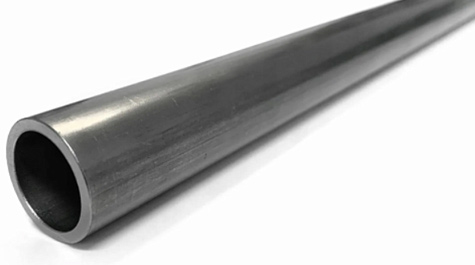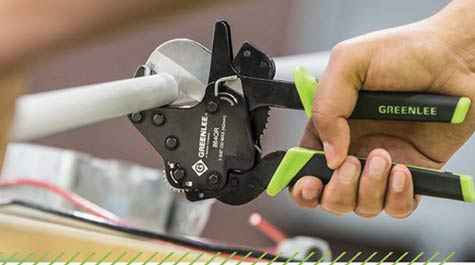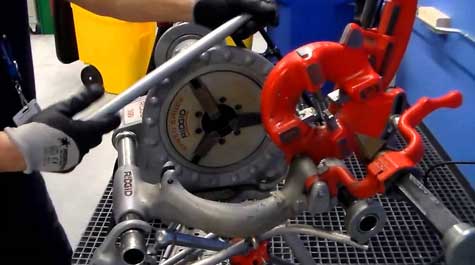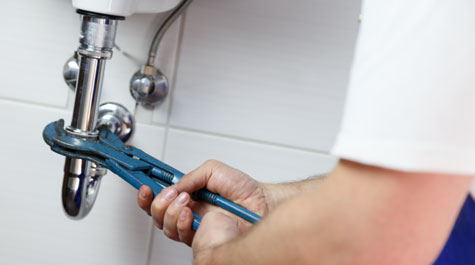Last Updated on April 25, 2023
Cutting and threading galvanized pipe can be a daunting task, but it can be done relatively quickly with the right tools and some practice.
This article will cover the tips and tricks on how to cut and thread galvanized pipe properly. We’ll also provide some tips to make the process go more smoothly.
What is Galvanized Pipe?

Galvanized pipe, sometimes referred to as “black pipe,” is the plumbing pipe typically used in homes and businesses.
The steel (or iron) wire wrapped around and under heavy zinc coatings on both the inside and outside make it solid and durable for transporting water over long distances.
How to Cut and Thread Galvanized Pipe: The best tips & tricks?
A few tips and tricks we’ve learned through the years will help make your job easier. The first step is to find out how to cut galvanized pipe?
Here is the best way to cut the galvanized pipe, in our opinion:
Using a Reciprocating Saw
This would be the best tool to cut the galvanized pipe if you have a reciprocating saw. This is primarily because many are built with blades for cutting metals like steel and iron. You can either buy one or rent one for this job.
Using an Angle Grinder
If you don’t have a reciprocating saw, an angle grinder works well. The blade is smaller and will require you to make more cuts for a given length of pipe, but the size of the tool makes it easier to handle.
If you’re considering taking out a payday loan online, it’s important to know that you cannot take a payday loan online without a bank account. This is because lenders require a valid bank account to deposit the funds and to set up automatic repayments. When you apply for a payday loan online, you’ll be asked to provide your bank account information, including the account number and routing number. This information is used to transfer the funds to your account once your loan is approved.
Using a Pipe Cutter

If you don’t have access to either of the two tools, a pipe cutter or tubing cutter can be used on steel or iron pipes. Be sure to get one designed for use with metals so it will not break when using it on the galvanized pipe.
Using a Chop Saw
The last option would be using a chop saw. A chop saw looks like a clamp-on magnifying glass with a circular blade attached to it. It’s designed for precision, but it can be challenging to get the angle right when cutting pipes.
Also, the edges are expensive and can only cut about 1/8 of an inch-thick metal at most (since the blades usually only cut up to about 1/8 inch deep).
After you’ve done all that, it’s time to start threading.
Threading galvanized pipe is easy. However, since the zinc coating on the outside of your piping can get in the way sometimes, here are a few tips for doing so more efficiently:
Using Tap/Die Sets
The best way to thread galvanized pipe is using a tap and die set; however, if you don’t have one of those, you can still do it with a regular plumber’s tape and a die.
Using Vice Grips
Clamp the threaded end of the galvanized piping into the vice grips as you did before. Make sure to tighten it enough so that the piping doesn’t move when being turned. This will give you an excellent clean cut with the threading tape.
Using a Pipe Threader

The best way to thread galvanized pipe is using a pipe threader. It will pull the tape all the way through and start your lines simultaneously. Plus, it’s easier to use than a tap and dies set!
Using a Tap and Die Set
Another method that works well is using a tap and die set. Screw the die into the end of the galvanized piping until it reaches the future, then back it out slightly.
This will start your threads. Then tighten down your tape to complete your threading process.
Using Plumber’s Tape
Finally, you can also thread galvanized pipe using a plumber’s tape. First, wrap the end of your piping with some plumber’s tape. Next, screw in your die until it cuts into the piping, then back it out slightly.
Finish tightening down the tap until it cuts through and pulls the tape through simultaneously.
Why is It Used in Plumbing?

Galvanized pipe is most commonly used in plumbing applications. This is because it can transport water from one place to another without leaking or corroding. We’ll go over a few different common types of galvanized piping and their applications below:
Galvanized Steel Pipe
Steel pipes are usually threaded on each end, or they can also be left plain.
Galvanized Iron Pipe
Iron pipes are usually threaded on each end.
Galvanized Fittings
Galvanized fittings connect galvanized piping to create whatever sizes you need for your project. Most galvanized pipe fittings are threaded, but some are slip fit as well.
Galvanized Elbows
Galvanized elbows can be used at a 90-degree angle to connect galvanized piping at the proper angle. They also typically have threads on both ends to screw into other fittings and pipes, if needed.
Galvanized Tees
Galvanized tees are used to connect 2 or 3 pieces of piping. They’re perfect for joining pipes at proper angles and typically have threads on both ends as elbows do.
Galvanized Crosses
A galvanized cross is excellent for connecting four pipes at the same angle.
Galvanized Caps
A galvanized cap can be used to plug an end of a pipe without having to cut off the end of it, which is excellent for saving time and money.
It also acts as a protective shield that keeps debris from getting into your piping, which could clog up your system and cause it not to function properly.
Galvanized Supports
Finally, galvanized supports are used to hold your piping up in the air, whether you’re using them outdoors or indoors.
They can also be attached to walls if needed for support, which makes them versatile pieces of hardware that can help complete various plumbing projects.
How to Clean Up After Yourself?
When you’re done threading your galvanized piping, be sure to remove all pieces of your piping threader and plumber’s tape. Before using the work again, soak it in warm, soapy water overnight.
This will help remove remnants & make it easier to undo if you need to use this tool for another plumbing project.
Conclusion
Threading galvanized pipe is a great way to connect different piping without using any welding or soldering. There are a few different ways to do this, but the most common methods are using a pipe threader, tap and die set, or plumber’s tape. Be sure to clean all of your equipment correctly when you’re finished so that it’s ready for your next plumbing project!


